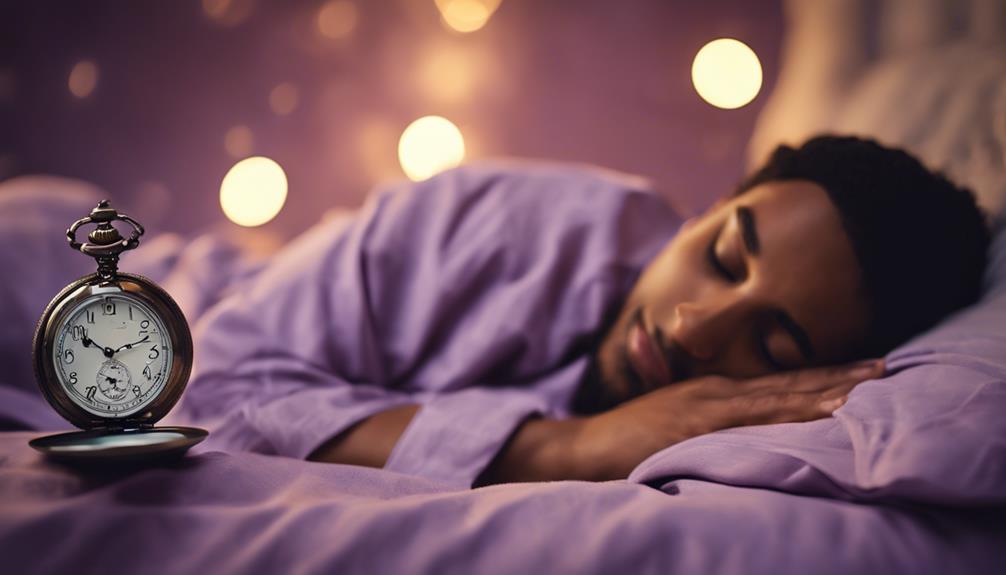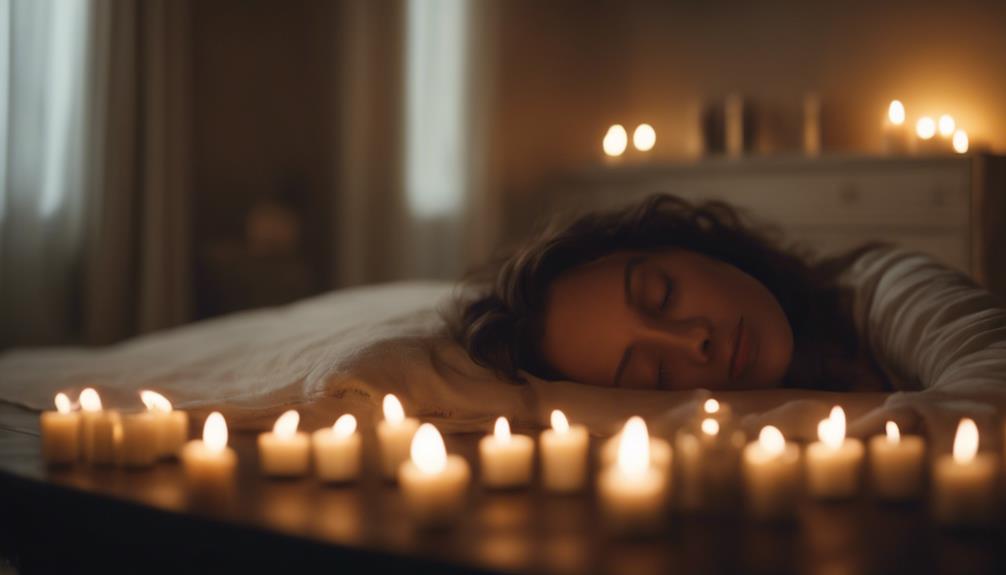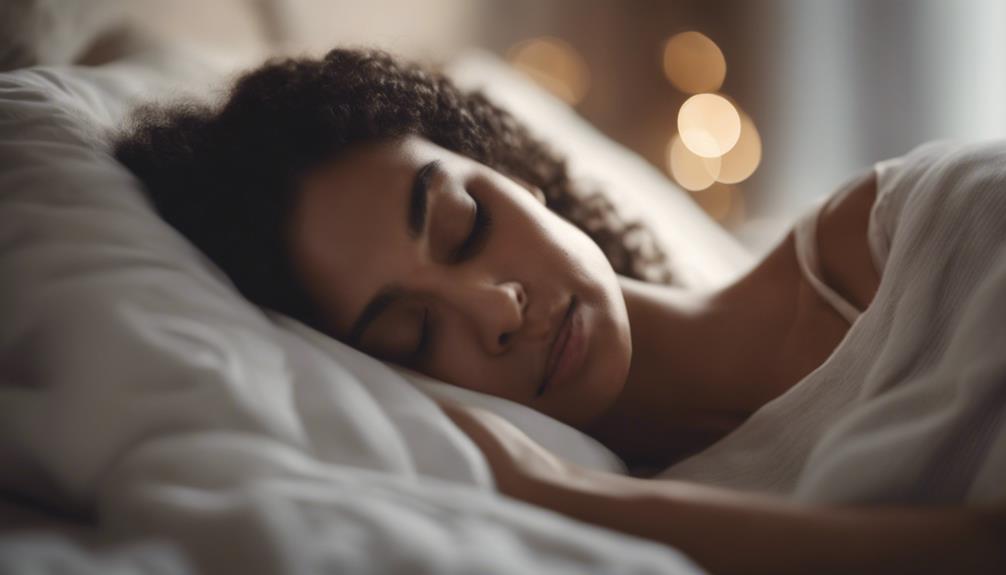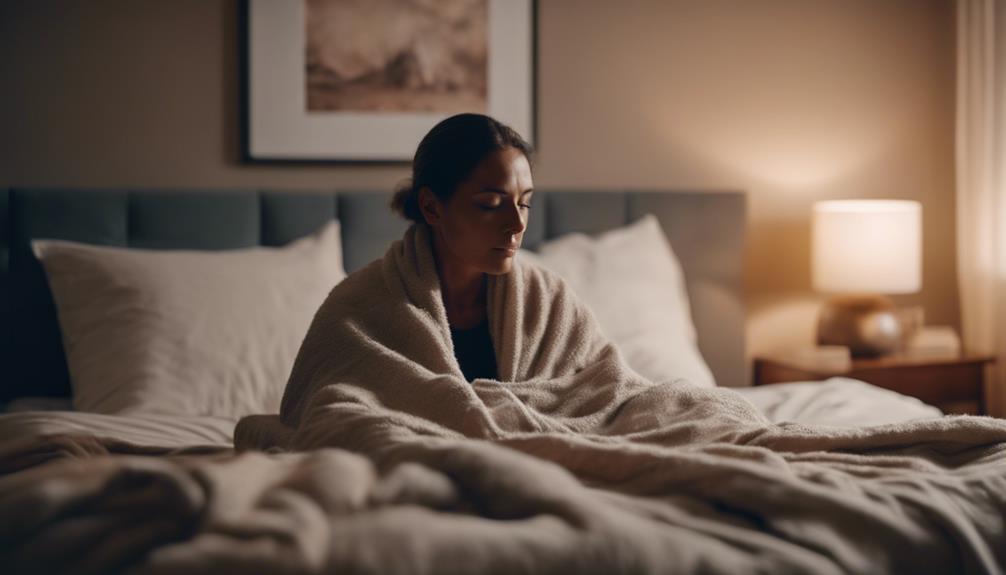
Improve your sleep and combat insomnia with these powerful hypnosis techniques. Try Progressive Muscle Relaxation to ease muscle tension and reduce stress. Deep sleep & insomnia relief if you Visualize peaceful scenes to trigger relaxation responses and enhance sleep quality. Empower yourself with Self-Hypnosis Techniques to control your sleep patterns and promote tranquility.
Deep Breathing Exercises activate the body’s relaxation response, preparing you for a restful night. Use Positive Affirmations for Sleep to create a peaceful mindset conducive to falling asleep. Explore Hypnotic Suggestions for Relaxation and Mindfulness Meditation for Insomnia to further enhance your sleep quality. Discover the secrets to deep relaxation and peaceful rest.
Key Takeaways
- Progressive Muscle Relaxation reduces stress for better sleep.
- Visualization & Guided Imagery induce relaxation responses.
- Self-Hypnosis empowers control over sleep patterns.
- Visualizing Peaceful Scenes before bedtime aids in relaxation.
- Deep Breathing Exercises activate the body’s relaxation response.
Progressive Muscle Relaxation
Progressive muscle relaxation is a widely practiced technique that involves systematically tensing and then relaxing muscle groups to induce a state of deep relaxation, often utilized to alleviate stress and promote better sleep quality.
By intentionally tensing specific muscle groups and then releasing the tension, individuals can become more aware of muscle tension throughout their bodies. This heightened awareness allows for a conscious relaxation response, helping to reduce overall muscle tension and promote relaxation.
When muscle tension is released through this technique, it can signal to the body that it is safe to relax, triggering a relaxation response. This response can help lower heart rate, decrease blood pressure, and reduce levels of stress hormones in the body.
As a result, practicing progressive muscle relaxation regularly can lead to improved sleep quality by promoting a state of calmness and relaxation before bedtime. By incorporating this technique into a bedtime routine, individuals may find it easier to unwind and drift off to sleep peacefully.
Visualization and Guided Imagery

Utilizing visualization and guided imagery techniques can be beneficial in promoting relaxation and aiding in achieving a restful sleep. Creative visualization involves creating a mental image of a peaceful and calming place, such as a serene beach or a tranquil forest, to help reduce stress and quiet the mind before bedtime. By engaging in imagery exercises, individuals can harness the power of their imagination to evoke sensory experiences that promote a sense of calmness and well-being.
During guided imagery sessions, a trained practitioner or through audio recordings, individuals are guided through a series of detailed mental images designed to elicit relaxation responses in the body. These exercises can involve imagining soothing scenes, focusing on specific sensations like warmth or gentle sounds, and incorporating positive affirmations to enhance feelings of comfort and security.
Self-Hypnosis Techniques

Self-hypnosis techniques offer individuals a powerful tool to reclaim control over their sleep patterns. Visualizing peaceful scenes, repeating calming affirmations, and utilizing guided relaxation audios are effective ways to induce a state of deep relaxation conducive to sleep.
These techniques empower individuals to cultivate a sense of inner peace and tranquility, paving the way for restful and rejuvenating sleep.
Visualizing Peaceful Scenes
To enhance the effectiveness of hypnosis for deep sleep and relief from insomnia, individuals can engage in a calming practice of visualizing peaceful scenes before bedtime. This technique leverages the power of mental imagery to create a serene environment within the mind, promoting relaxation and aiding in the shift to a restful state.
Visualizing tranquil landscapes or nature escapes can help calm the mind and reduce stress levels, preparing the body for a night of rejuvenating sleep. Dream visualization allows individuals to immerse themselves in soothing scenarios, fostering a sense of peace and tranquility that is conducive to falling asleep easily.
Here are three ways to incorporate visualizing peaceful scenes into your bedtime routine:
- Choose a specific peaceful scene that resonates with you, such as a beach at sunset or a serene forest.
- Focus on the sensory details of the scene, including the sights, sounds, and scents, to fully immerse yourself in the visualization.
- Practice this technique regularly before bedtime to train your mind to associate these calming images with sleep, promoting a more restful night.
Repeating Calming Affirmations
Incorporating calming affirmations into one’s bedtime routine can be a powerful self-hypnosis technique for promoting deep relaxation and alleviating insomnia symptoms.
Sleep affirmations, when used consistently before sleep, can help calm the mind and body, creating an ideal environment for a restful night’s sleep.
Bedtime routines that include relaxation mantras can signal to the brain that it is time to unwind and prepare for rest, reducing the impact of stress and anxiety that often contribute to insomnia.
Guided Relaxation Audio
Utilizing guided relaxation audio during bedtime can enhance the efficacy of hypnosis techniques for promoting deep sleep and alleviating insomnia symptoms. These audio recordings are designed to induce a state of deep relaxation, making them a valuable tool in improving sleep hygiene and overall well-being.
Here are three ways in which guided relaxation audio can be beneficial:
- Promoting Sleep Hygiene: Guided relaxation audio can help establish a calming bedtime routine, signaling to the brain that it is time to unwind and prepare for rest. By consistently incorporating these audio sessions into your nightly routine, you can create a conducive environment for deep sleep.
- Facilitating Mindful Breathing: Many guided relaxation audios incorporate mindful breathing exercises, which can help quiet the mind and relax the body. Mindful breathing techniques have been shown to reduce stress and anxiety, making them particularly useful for individuals struggling with insomnia.
- Enhancing Hypnotic Suggestions: Guided relaxation audios often include hypnotic suggestions aimed at promoting relaxation and positive sleep associations. By listening to these suggestions regularly, individuals can reinforce positive sleep behaviors and improve their overall sleep quality.
Deep Breathing Exercises

Practicing deep breathing exercises regularly can greatly enhance your ability to relax and unwind, aiding in better sleep quality and insomnia relief.
Diaphragmatic breathing, commonly known as deep breathing, involves taking deep breaths to fully expand your lungs, engaging your diaphragm. This technique activates the body’s relaxation response, reducing stress and promoting a sense of calmness conducive to falling asleep.
Incorporating breathwork techniques into your bedtime routine can be a powerful tool for improving sleep. By focusing on your breath, you can quiet the mind, release tension, and prepare your body for a restful night.
Deep breathing exercises not only help in the moment but also contribute to long-term benefits by training your body to naturally relax and unwind before bedtime.
Whether you practice deep breathing on its own or as part of a thorough relaxation routine, these simple yet effective techniques can play a significant role in enhancing your sleep quality and providing relief from insomnia.
Positive Affirmations for Sleep

Positive affirmations can be a powerful tool in promoting relaxation and enhancing sleep quality. By harnessing the power of positive thinking, individuals can cultivate a mindset conducive to restful sleep.
Self-soothing bedtime mantras can help calm the mind and create a peaceful environment for falling asleep.
Affirmations for Relaxation
When seeking relaxation and improved sleep quality, incorporating affirmations into your nightly routine can be a powerful tool to promote a sense of calm and tranquility. Affirmations serve as positive reinforcements that can help rewire your mindset towards relaxation and peace.
Here are some effective ways to integrate affirmations for relaxation into your bedtime routine:
- Affirmation Journaling: Dedicate a few minutes before bed to write down affirmations that resonate with you. Reflect on positive experiences from your day and channel that positivity into your affirmations.
- Positive Mindset Exercises: Engage in activities that uplift your mood before bedtime. Whether it’s reading inspirational quotes or practicing gratitude, fostering a positive mindset can enhance the effectiveness of your affirmations.
- Stress Relief Mantras and Calmness Visualization Techniques: Repeat soothing mantras or visualize serene settings to ease stress and induce a state of calmness before sleep. These techniques can help quiet the mind and prepare your body for deep relaxation.
Power of Positive Thinking
Harnessing the power of positive thinking through affirmations can greatly enhance your sleep quality and overall well-being. Positive affirmations are powerful statements that can help reframe negative thought patterns and promote relaxation before bedtime. By incorporating positive affirmations into your nightly routine, you engage in cognitive restructuring, which involves challenging and changing unhelpful beliefs.
Positive affirmations for sleep can be tailored to address specific concerns such as insomnia, stress, or anxiety. Examples of positive affirmations include ‘I am calm and peaceful,’ ‘I deserve a restful night’s sleep,’ and ‘I trust my body to relax and rejuvenate during sleep.’ By repeating these affirmations regularly, you can shift your mindset towards one that is more conducive to a peaceful night’s rest.
Cognitive restructuring through positive affirmations helps cultivate a more optimistic outlook, reduces bedtime worries, and promotes a sense of calmness that is essential for falling asleep easily.
Embracing the power of positive thinking through affirmations can be a valuable tool in improving your sleep quality and overall mental well-being.
Self-Soothing Bedtime Mantras
Utilizing self-soothing bedtime mantras, or positive affirmations for sleep, can be a gentle yet powerful tool in promoting relaxation and improving sleep quality. Incorporating these calming phrases into your bedtime routine can help quiet the mind, reduce stress, and set the stage for a restful night’s sleep.
Here are three ways self-soothing bedtime mantras can enhance your sleep hygiene and overall well-being:
- Stress Management: Positive affirmations can serve as a coping mechanism for stress and anxiety, helping to shift focus away from worries and towards a more peaceful mental state before sleep.
- Relaxation Techniques: By repeating soothing mantras such as ‘I am calm and at peace’ or ‘My mind and body are ready for rest,’ you can signal to your body that it’s time to unwind and prepare for sleep.
- Enhanced Bedtime Routine: Integrating self-soothing bedtime mantras into your nightly ritual can gradually train your mind to associate these affirmations with relaxation, making it easier to shift into a restful slumber.
Hypnotic Suggestions for Relaxation

In the realm of hypnosis methods aimed at enhancing deep relaxation, integrating carefully crafted hypnotic suggestions can act as a potent tool to induce a state of profound calmness and peacefulness.
Hypnotic breathing methods, relaxation mantras, sleep-inducing visualizations, and guided affirmations are crucial components in this process.
Hypnotic breathing methods involve deep, rhythmic breathing patterns that assist the individual in entering a relaxed state. These methods can be paired with soothing relaxation mantras, repeated phrases that encourage peace and tranquility.
Sleep-inducing visualizations guide the mind to envision serene settings or scenarios, facilitating a shift to a more restful state. Furthermore, guided affirmations are positive declarations that strengthen relaxation and support improved sleep.
When utilized in hypnosis, these suggestions can bypass the critical mind and directly impact the subconscious, nurturing a profound sense of relaxation. By integrating these hypnotic suggestions effectively, individuals can enhance their capacity to achieve deep relaxation and alleviate insomnia symptoms.
Mindfulness Meditation for Insomnia

Mindfulness meditation serves as a powerful practice for individuals seeking relief from insomnia by fostering a heightened awareness of the present moment and promoting relaxation. Incorporating mindfulness practices into a bedtime routine can help calm the mind, reduce stress, and create the best environment for restful sleep.
When struggling with insomnia, integrating mindfulness techniques can greatly improve sleep quality and duration. Here are three key ways mindfulness meditation can assist in managing insomnia:
- Promotes Relaxation: Mindfulness practices encourage deep relaxation, easing the mind and body into a state conducive to falling asleep.
- Enhances Sleep Hygiene: By incorporating mindfulness into bedtime rituals, individuals can establish a healthy sleep routine, improving overall sleep hygiene.
- Reduces Anxiety and Racing Thoughts: Mindfulness meditation helps in quieting the mind, reducing anxiety levels, and preventing racing thoughts that often contribute to insomnia.
Frequently Asked Questions
Can Hypnosis Be Used to Treat Sleep Disorders Other Than Insomnia?
Hypnosis shows promise in assisting with sleep apnea treatment by promoting relaxation and potentially improving breathing patterns during sleep. However, its effectiveness in managing narcolepsy is less established and requires further research for conclusive recommendations.
How Long Does It Take to See Results From Hypnosis for Sleep?
The timeline for hypnosis effectiveness in treating sleep issues varies. Patients may notice improvements in as little as a few sessions, while others may require more time. Success rates are higher when patients maintain realistic expectations and commit to the process.
Are There Any Potential Side Effects of Using Hypnosis for Sleep?
Just like any therapeutic method, hypnosis for sleep may present potential side effects. Risks involved include minor disorientation or heightened emotional sensitivity. Although its effectiveness is questioned by some, proper guidance minimizes adverse outcomes.
Can Hypnosis Be Combined With Other Sleep Aids or Medications?
When considering the combination of hypnosis with other sleep aids or medications, it is important to consult with a healthcare provider. Synergy between hypnosis and certain sleep aids may be beneficial, but potential interactions and effects should be carefully assessed.
Is Hypnosis Safe for Individuals With Mental Health Conditions Like Anxiety or Depression?
Hypnosis can be safe for individuals with mental health conditions like anxiety or depression when conducted by a trained professional. While some may have concerns, research indicates hypnosis effectiveness in addressing mental health issues with proper guidance.
Conclusion
To wrap up, these hypnosis techniques offer a promising path towards achieving deep sleep and relief from insomnia.
By incorporating practices such as progressive muscle relaxation, visualization, and deep breathing exercises, individuals can tap into the power of their subconscious mind to promote relaxation and restful sleep.
While the irony of seeking sleep through hypnosis may seem counterintuitive, the potential benefits are worth exploring for those struggling with sleep disturbances.
Take the Next Step, Make An Appointment
Do not be afraid to reach out to me, Mark , to assist you in any issues you might have. Need a good listener or someone to confidentially talk too? . Life Coaching is 45 minute session, once a week.
Self-Hypnosis is taught in one session, individual sessions or in a group, and lasts a lifetime. Most Hypnotherapy sessions including Age regression last 2 hours and EFT Sessions are usually handled with a one hour session
To make an appointment, first listen to the Pre-talk and fill out the Complementary Healthcare Provider Disclosure. The use the Contact Form to request an appointment with, Mark, The Bohol Hypnosis Expert.
Self-help downloads are available to help you with specific problems. The self-hypnosis program to teach you how to self-hypnotize yourself is available here.





